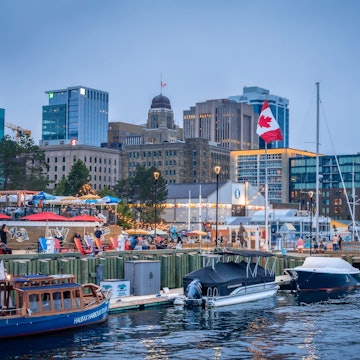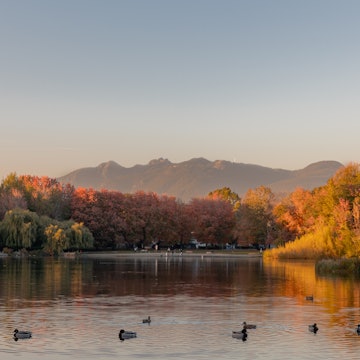

Spread out into Montréal neighborhoods like the Plateau to get a taste of local life. Andriy Blokhin/Shutterstock
Sprawling across along an island in the St Lawrence River, Montréal is a city of vibrant neighborhoods. In these diverse districts, visitors can get a strong sense of the city’s blend of French and English heritage – indeed, its very soul.
Historic, cobbled streets and centuries-old architecture make Old Montréal a focal point for most visitors, while nearby Chinatown hides colorful streets packed with tantalizing restaurants, bakeries and tea parlors. Bustling Downtown is the go-to for museums, the Quartier Latin and the Village are full of students and LGBTIQ+ entertainment, and the Plateau has leafy parks and creative nightlife.
Most areas are made for exploring on foot, and getting from one to another is a breeze thanks to Montréal’s efficient bus and metro network.
Here are the neighborhoods in Montréal you can’t miss.

1. Old Montréal
Best for exploring
The oldest part of Montréal has a strongly European feel, thanks to its cobbled lanes, cafe-fringed squares and Second Empire architecture – in particular, the grand Hôtel de Ville (aka City Hall). Indeed, Old Montréal is a paradise for the flâneur (wanderer). Peek inside grand churches (don’t miss a visit to the Chapelle Notre-Dame-de-Bon-Secours, with its boat-shaped votive lamps left by sailors in thanks for safe voyages). Check out hidden street art (like the bronze sculpture of Les Chuchoteuses, which helped revitalize the district back in the early 2000s). There’s even a little-known chunk of the Berlin Wall tucked inside the Montréal World Trade Centre.
There’s great shopping here, too, at one-of-a-kind boutiques. At L’Empreinte Coopérative, you can browse wide-ranging ceramics, jewelry and crafts made by Québécois artisans. Nearby, the Boutique Boréale has an array of works by First Nations artists: leather moccasins, woven blankets, musk-ox fur hats and carvings in fossilized mammoth ivory. Keep following photogenic Rue St-Paul to reach the Marché Bonsecours, Old Montréal’s domed market hall, full of shops selling yet more crafts and clothing as well as Canadian food items (think chocolate-dipped blueberries and maple-syrup liqueurs).
When it comes to dining, the neighborhood has its share of forgettable tourist traps – yet it’s also home to some of Montréal’s most creative restaurants. There’s superb vegetarian and vegan cuisine at LOV, while Barroco and Garde Manger showcase New Canadian cooking.
Afterward, you can explore the bar scene, which encompasses friendly, easy-going watering holes like the Pub St-Paul, as well as stylish cocktail dens (Clandestino, Tittle Tattle) and rooftop bars (the Terrasse Place d’Armes).

2. Downtown
Best for museums, food halls and shopping
Montréal’s bustling Downtown is much more versatile than your average central business district. Sure, there are loads of office workers and wide, traffic-filled streets – but le centre-ville is also home to vibrant squares, grand architecture and the city’s best museums.
The massive Musée des Beaux-Arts stages Montréal’s blockbuster exhibitions, while also housing an impressive permanent collection of artwork from around the globe. For exploring Canadian history from Neolithic times to the present, hit up the Musée McCord Stewart. Elsewhere, you’ll find specialized museums like the Musée Redpath, which feels like a Victorian cabinet of curiosities with its displays of dinosaur bones, meteorites and other oddities from the natural world.
The dizzying Downtown restaurant scene can be difficult to navigate. For the most variety in one space, head to one of the area’s many food halls. Hidden below ground (but not lacking natural light thanks to a glass ceiling), Le Cathcart has a main hall and beer garden, with a dozen or so dining options on the periphery. Dishes roam the globe at Time Out Market Montréal, making it a prime spot for Indian tandoori, Haitian accra fritters or Lebanese-style lemon confit chicken. Le Central has the widest selection of options, from lobster rolls at Gaspésie to piping-hot churros from Mignon. It’s also located near Place des Arts, with several impressive halls that stage ballet, theater and classical-music performances.

3. Chinatown
Best for Asian dining and hidden nightlife
A few blocks from the edge of Old Montréal, Chinatown occupies just a couple of square blocks – and it’s packed with atmosphere. Most people come here to eat: a two-block-long stretch of Blvd St-Laurent is cluttered with culinary temptations. Expect to find authentic Hong Kong–style bakeries with heavenly soft sponge cake (try Pâtisserie Coco), elegant dim-sum parlors hidden in upstairs shopping galleries (Ruby Rouge), and glittering windows behind which adroit chefs toss and stretch hand-pulled noodles (Nouilles de Lan Zhou).
But there’s more than just Chinese food in Chinatown. You’ll also find standout spots for Vietnamese cooking (like Pho Bang New York), Korean fare (Kalbi BBQ) and Japanese fondue (Shabu Shabu Kagayaki). A new-ish arrival is La Capital Tacos, a hip, minimalist eating and drinking space serving up perfectly spiced versions of its namesake.
In the evening, the bustling daytime crowds disperse, and Chinatown sinks into slumber – except for its barely signposted speakeasies. There’s a fun vibe at Le Mal Necessaire, a nouveau tiki bar that serves decadent tropical concoctions like the Piña Fuego, which is served in a flaming, hollowed-out pineapple. It’s an adventure finding your way into candlelit Sans Soleil, one well worth the effort. Here, the expert bartenders stir together elaborate cocktails, and you can order food (try the sashimi) from the restaurant upstairs.

4. Quartier Latin and the Village
Best for student life and LGBTIQ+ entertainment
The Quartier Latin (Latin Quarter) is home to the Université du Québec à Montréal (UQAM), which draws French-speaking students from three continents. Student life permeates the streets of this compact district, particularly along Rue Saint-Denis, with its earth-friendly cafes, inexpensive restaurants and youthful bars. Unique options include Le 4ème Mur, a well-concealed speakeasy (find the special brick to open the door), and Pub l’Île Noire, which has with a front terrace that’s ideal for people-watching. The Quartier Latin also has fairly inexpensive lodgings catering to the university crowd.
East of the Quartier Latin is the Gay Village, often just called Le Village. This is the epicenter of LGBTIQ+ life in Montréal, especially during big annual events like Montréal Pride, held in August. Rue Sainte-Catherine Est, the main strip, is dotted with iconic spots like Le Date, one of Montréal’s best karaoke bars, and Cabaret Mado, famed for its deliciously outrageous drag shows. Later in the night, Le Village attracts revelers of all persuasions to massive nightclubs like Complexe Sky, which has different dance floors to help you find your groove.

5. The Plateau
Best for parks and live local music
One of Montréal’s most emblematic neighborhoods, the Plateau is a former working class district turned bohemian artist enclave, turned… something more gentrified today. Still, the area hasn’t fully abandoned its free-spirited ethos.
The Plateau doesn’t have much in the way of museums or other traditional sights, but it is home to some of Montréal’s best-loved green spaces. Foremost among them is the Parc du Mont-Royal, which has forested trails, a lake, and dramatic lookouts over the city. Smaller, easier-to-reach Parc La Fontaine is a favorite for picnics overlooking the serpentine pond, which fills with ice skaters in winter. On precipitation-free days, locals stroll with their dogs and children over to the Carré St-Louis, a small, verdant square framed by elegant 19th-century houses. The well-placed Kiosque K sells coffee and pastries, and the park benches sometimes host impromptu music jams.
Speaking of music, the Plateau hosts the best summertime Sunday gathering: Les Tams-Tams du Mont-Royal, when drummers, dancers and picnickers come together on the lawn near the Sir George-Étienne Cartier monument. For more conventional entertainment, the Plateau has much-loved spots like the Casa del Popolo, with a lineup of indie folk, Brazilian beats and experimental theater. Elsewhere in the Plateau, you’ll find intimate spots for live jazz (Diese Onze); friendly rock-loving bars with DJs and the odd band (La Rockette); and more-polished venues for concerts and the occasional burlesque show (La Tulipe).
















